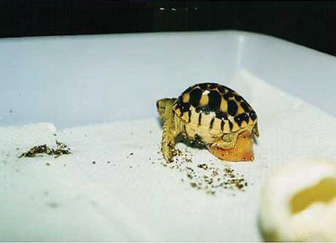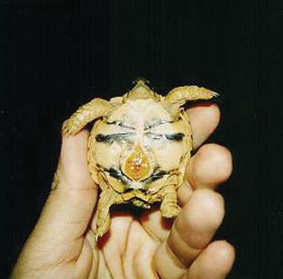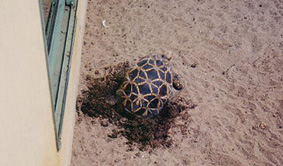
![]() BREEDING THE BURMESE STAR TORTOISE (Geochelone platynota)
BREEDING THE BURMESE STAR TORTOISE (Geochelone platynota)

Rajanta Sinardja Rahardja
After reading some publications about some of the behavior of the Geochelone platynota (Burmese Star) in the wild, I would like to share my limited experience in keeping this beautiful and hardy tortoise. One of the aspects that I want to share is the behavior of this tortoise in relates to water existence and needs in captive environment. I have been keeping this tortoise for about four years. I have three pairs of adults. I also have one juvenile and one hatchling. I keep my six adults in my 36 square meters backyard. The substrate that I have been using is a 50/50% mix of sand and dirt. I also provide water for drinking and soaking in a one square meter space on the corner of my backyard. For the juvenile tortoise, I put her in a terrarium with a 25 watts light bulb to warm the night. I still put the hatchling in a wooden box that mimics the temperature and humidity of my homemade wooden incubator. This has been working nicely. I always soak the juvenile and the hatchling for at least 15 minutes in the morning before I feed them. I put them in protected area to enjoy the sun for basking outside their terrarium/box.

I feed a mix of green vegetables such as kale and hibiscus leaves. I always feed the juvenile and the hatchling with kale and hibiscus leaves with added mineralsand vitamins.
The annual rainfall in the wild is very low and this may explain the behavior that I have been seeing when rain comes in my hometown (Indonesia has a very high rainfall). The tortoises always seem restless when the weather is turning cloudy. This behavior is very obviously shown by the juvenile tortoise. Usually, the juvenile tortoise looks lethargic and very shy when I put her back in her terrarium in the evening. She usually just tries to find a spot to sleep. However, when the weather starts to get colder and it is about to rain, she starts to wander around anxiously to go out from her terrarium. This behavior not only happens once. Whereas for the adults, they start to wonder out from their 1.2 x 1 meter square house that I built. They like to drink the water from the rain that stays in the puddle than the water that I provide everyday. The other behavior that relates to the water requirement is when a female Burmese wants to lay eggs.

From previous observations, the female would stay submerged in water for about four days non-stop, except to eat. The water is needed to soften the soil, so she can dig the hole easier. From my limited experience, I would like to try to give an explanation to this behavior. From some publications that I read, people can find this tortoise in the wild easier in the rainy season than in the dry season. And because the wild sanctuary is a quite dry place, the opportunity for these tortoises to carry out such activities are limited to the rainy season. That is maybe why my tortoises show more activities when the rain comes. I am not sure whether my limited experience will help future research for this lovely tortoise.
(c) Tortoise Trust 2007